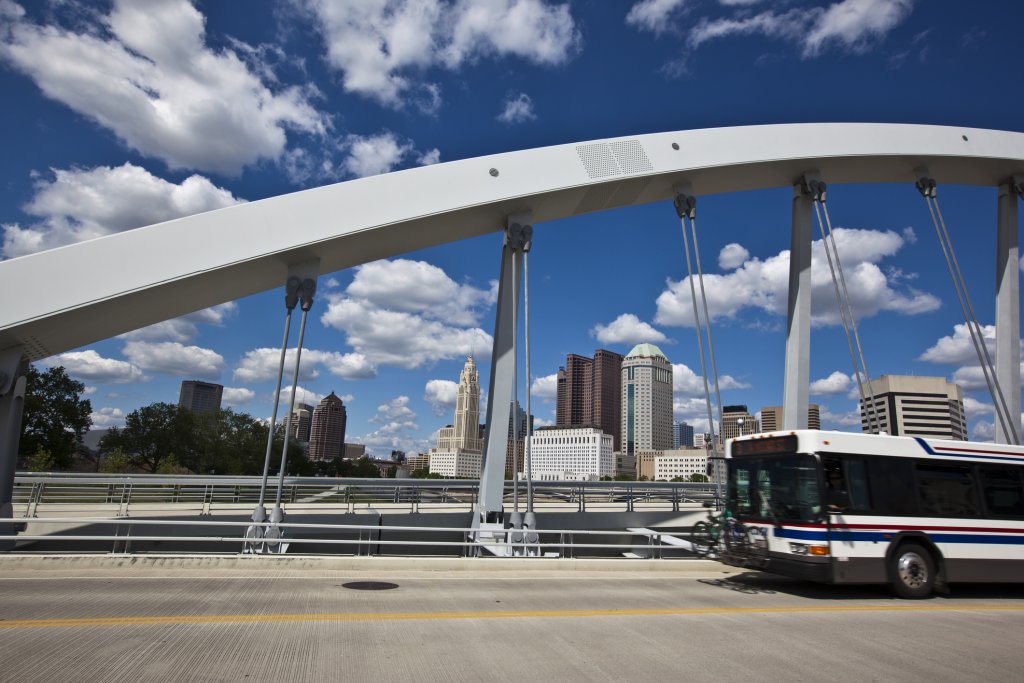A Central Ohio Transit Authority bus in Columbus. Getty photo.
Last month, Sarah Conlisk, a data editor at Lyft, reported that Ohio’s Capital, Columbus, had the best commute in the country among cities with over half a million population.
Conlisk’s analysis combined a few metrics into four different categories: speed, cost, clean (greenhouse gas emissions), and after-work activity. Commutes that were shorter, cheaper, less greenhouse gas-intensive, and had more downtown amenities to ease the burden of the commute were rated higher.
Columbus nabbed the top spot because of its high performance on two dimensions: speed and cost. In speed, Columbus finished top in the country, with American Community Survey data showing an average commute time of only 22 minutes and Lyft data showing an average speed of over 24 miles per hour. This means Columbus commutes were short and that Columbus commuters dealt with less gridlock than other cities.
When it came to cost, Columbus also fared well. The average Columbus commuter spent $35 a month on parking and $29 a month on fuel. This compares favorably to other large cities such as Tucson and Phoenix, Arizona, where commuters spent $60 a month on parking, and Las Vegas, where commuters spent $42 a month on fuel.
Unfortunately, we don’t have data for Akron, Cincinnati, Cleveland, Dayton, Toledo, or other major cities in Ohio since they did not meet the size cutoff.
Commute times may seem like a mundane topic, but commutes have a large impact on peoples’ lives. Even the four minutes of average commute time difference between Columbus and Las Vegas shakes out to over 30 hours longer spent in a car commuting over a typical year for a full-time worker.
They also have an impact on the environment. Among the top ten cities for commuters, Columbus ended up having the lowest score for “clean” commuting. The methodology Conlisk uses to calculate the clean score is opaque, but seems to be based on modes of transportation used by commuters. Columbus scored an 11 out of 100 on the rating while all the other top-10 cities scored from 26 (Las Vegas) to 42 (Detroit).
The results of this underscore an important message about public transportation, sustainable transportation, and diversification of transportation options: if your commute is easy, you will not take the bus.
Public transportation advocates have pointed to state funding as the culprit for low transit ridership in Ohio. There is some truth to this: the state spent an inflation-adjusted $52 million in general revenue funds on public transportation at a high mark in public funding in 2002. Funding was cut in subsequent years, and while it has recovered somewhat during the DeWine administration, it was still at $37 million in FY 2024, $15 million below its amount 20 years earlier.
Despite state funding challenges and the public rhetoric around service in Ohio, public transportation quality is quite good. In 2018 and 2020, the American Public Transportation Association awarded the Central Ohio Transit Authority with its Outstanding Public Transportation System Achievement Award, recognizing it for the quality of service.
But when push comes to shove, it doesn’t matter how frequent, convenient, or high-quality public transportation is. As long as gas is cheap and rides are short, people will drive. Investments in public transportation and bike infrastructure will have some marginal impacts on these trends, but the only thing that will create significant mode shifts is if people start feeling it at the pump or in gridlock. Only then will they start looking toward a nationally-renowned bus system as an option.
YOU MAKE OUR WORK POSSIBLE.

